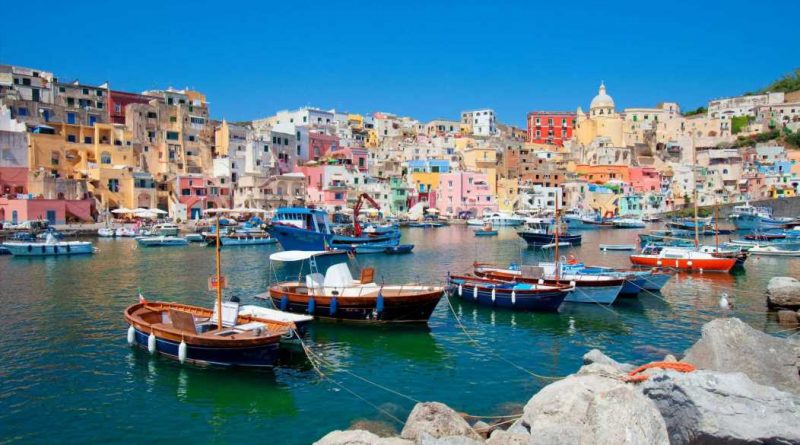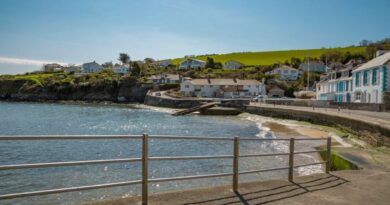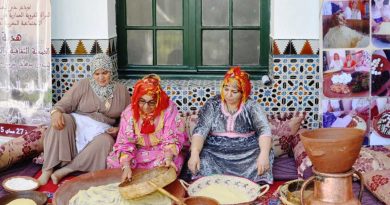This Tiny Island Was Named Italy’s Capital of Culture for 2022
Procida, a tiny spot of land in the Bay of Naples, might be best known as the island between Ischia and Capri. But in late January, it was named Italy’s Capital of Culture for 2022, beating nine other candidates—a mix of cities and small towns—and becoming the first island to ever be granted the title.
Under two square miles in total, the island has mostly flown under the tourist radar (except in July and August, when many Neapolitans come here for their summer vacations), overshadowed by its better-known siblings. This is all despite its big-screen moments—Procida has served as the set of The Talented Mr. Ripley and Il Postino—and the fact that it features the same pastel houses, cafes-lined marinas, and narrow streets as its bigger counterparts, but also historic sites, wild nature, and near-empty beaches.
The Capital of Culture announcement was marked by church bells and celebrations among its 10,500 inhabitants. “It was a moment of real pride for all of us,” says mayor Raimondo Ambrosino. “But it also felt like a recognition that’s been a long time coming.”
The proposal that earned the island the award—and 1 million euros—includes 44 projects spanning art, urban regeneration, environmental sustainability and more, involving 240 artists and 40 original works.
“We wanted to demonstrate that Italy’s cultural wealth isn’t just found in its larger cities, but also in those places that are considered minor, even marginal: our islands and borghi,” says Agostino Riitano, the project manager behind Procida’s candidacy.
Procida’s residents are thrilled for the recognition, though they plan to make sure the island maintains its humble roots. “Procida has always been a fisherman’s outpost first,” says Tarcisio Ambrosino (no relation to the mayor), the owner of Vineria Letteraria L’Isola di Arturo, a wine bar-meets-literary event space in Corricella, the island’s 17th-century port and oldest fishing village. “I don’t think we’ll suddenly become a second Ischia or Capri. It’s just not in our nature.”
Marina Caliendo, front office manager of boutique hotel San Michele, echoes the same sentiments. “Procida is for a slower kind of travel,” she says. “There’s no glitz here—no designer shops, or fancy thermal spas. What’s important, with this prize, is that we’re careful to keep our traditions.”
To that end, both Riitano and mayor Ambrosino say the calendar of events highlights Procida’s history and identity, and preserve “a place that follows its own rhythm, and where tranquility is still one of the main attractions.”
Getting to Procida
Procida lies 14 miles off the coast of Naples. There are daily ferries and hydrofoils leaving from two of the city’s piers, Molo Beverello and Porta di Massa, as well as from Pozzuoli, just north of Naples. Depending on the ride—the faster hydrofoil or the slower ferry—you’ll get to the island in 40 minutes to 1 hour. You can also travel from Ischia—that’s a 15- to 25-minute journey.
What to see and do
Arriving at Marina Grande, Procida’s main tourist port, you’ll see a cluster of traditional houses along the waterfront, each one painted in vivid shades of pink, yellow, orange, red, and blue—traditionally a way for fishermen to identify them from their boats.
Via Roma, Procida’s main street, is right around the corner from the port, and a good spot for lunch—especially at La Medusa, which has been around since 1954. Before you move on, stop for an espresso at Bar Roma and make sure to order lingua di suocera (‘mother-in-law’s tongue’), Procida’s traditional puff pastry filled with lemon custard. Chiesa di Santa Maria della Pietà, an 18th-century church with an iconic baroque belfry, and the lemon-yellow church of Santa Maria delle Grazie, built in 1679, are also nearby and worth a visit.
From here, it’s a 15-minute walk uphill (then downhill) to Marina Corricella, Procida’s oldest fishing village. Only reachable on foot or by boat, the area is one of the best places to stay for a taste of slow island living, and is full of restaurants—Caracale, La Lampara, Il Pescatore, to name a few—gelato shops like Chiaro di Luna, and bars.
At the opposite end of the island, Marina Chiaiolella is another fishing village with great eateries (try Da Mariano and Lido Vivara), craft boutiques, and old-school bakeries—not to mention access to one of the island’s most popular beaches, spiaggia della Chiaiolella, known for its sunsets.
Terra Murata, the fortified medieval stronghold at the highest and northernmost tip of the island, is another highlight. A tumble of skinny lanes and crumbling houses, this is Procida’s most historical center, home to Abbazia San Michele Arcangelo, which honors Procida’s patron saint, and Palazzo D’Avalos, a 16th-century palace that was the former residence of the island’s governing family. In 1830 the building was converted into a prison that eventually closed in 1988. Two viewpoints here offer the island’s most panoramic vistas: Corricella in all its candy-colored glory to the west; and the Gulf of Naples, with Capri in the distance, to the east.
Beaches and nature
Among Procida’s most scenic beaches are Pozzo Vecchio, whose black sands were made famous in Il Postino; spiaggia Chiaia, to the east, which overlooks Ischia and features clear, shallow waters and a backdrop of rocky cliffs (plus the excellent seafood restaurant La Conchiglia); and Ciraccio, the longest and most secluded. Further down, the spiaggia della Chiaiolella is another gem, though slightly more frequented, especially in the late afternoon, when its stabilimenti (beach clubs with rows of sunbeds and umbrellas) start rolling out aperitivo.
Don’t miss Isola di Vivara, a protected nature reserve that occupies a tiny crescent-shaped islet and is linked to Procida by a long bridge. Privately owned but open to visitors a few times a week, it’s a testament to the island’s rich natural beauty.
Where to stay
The San Michele, in Corricella, has 12 tastefully decorated rooms done in earthy tones and minimalist design. A similar aesthetic is found in its slightly bigger sister property La Suite, a stylish accommodation near Ciraccio that comes with a pool, a garden, and striking views.
In Chiaiolella, the three-star Hotel Ristorante Crescenzo is a popular choice not just for its simple, brightly colored rooms but its pizzeria, one of the most famous in Procida. La Vigna, in a beautifully restored farmstead within a vineyard that overlooks the Bay of Naples, delivers charm and tranquility.
All listings featured in this story are independently selected by our editors. However, when you buy something through our retail links, we may earn an affiliate commission.
Source: Read Full Article



